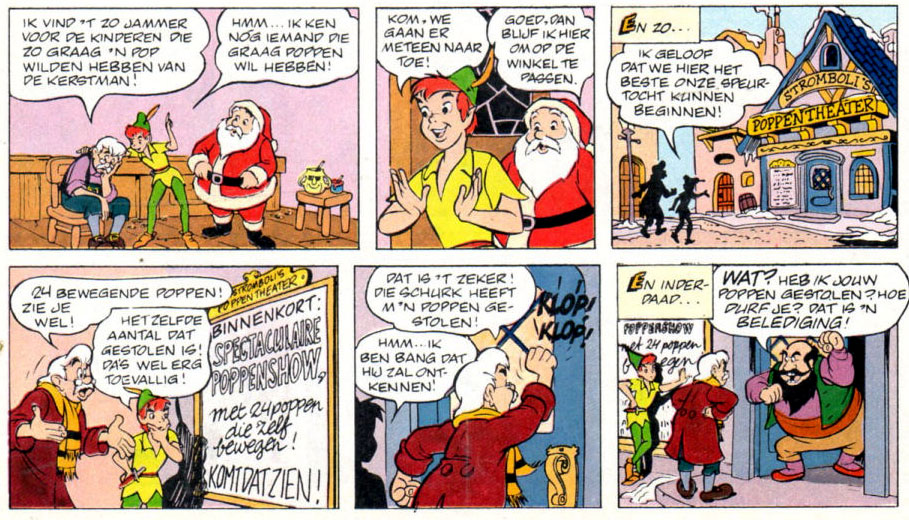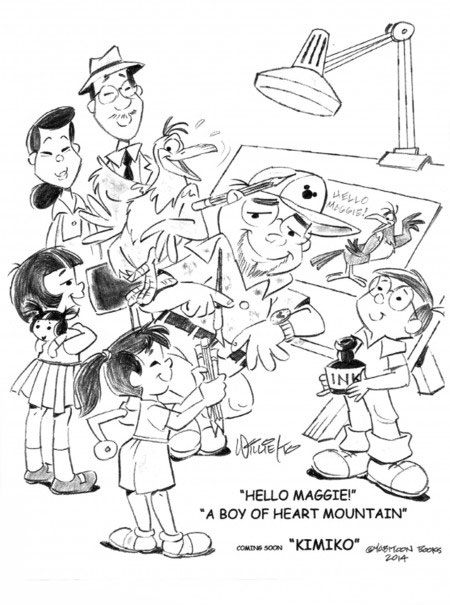Willie Ito is an American animator who worked for the three major and classic Hollywood animation studios: Disney, Warner Brothers and Hanna-Barbera. From the 1960 until the 1990s, he also drew comic stories with characters of those studios. He published cartoons and comics in Car-Toons magazine and assisted on Walt Kelly's newspaper comic 'Pogo' for one week in 1973. However, he is best remembered as a Disney and Hanna-Barbera comic artist.
Early life
Willie Ito was born in 1934 in San Francisco as the son of Japanese immigrants. At age three, he first saw Walt Disney's 'Snow White and the Seven Dwarfs' (1937) and was so mesmerized by the scene of the dwarfs marching over a log singing "Heigh-Ho", that he wanted to become an animator. He was also fascinated by Disney's 'The Reluctant Dragon' (1941), which featured (staged) behind-the-scenes footage of Disney's animation department.
POW jail time
Unfortunately, in 1941 the Japanese army attacked the U.S. military basis Pearl Harbor. The United States entered World War II and president Franklin D. Roosevelt signed a controversial executive order which led to the internment of several Japanese Americans in U.S. POW camps, solely based on their ethnicity. Eight-year old Ito and his family were among many Japanese American citizens to be incarcerated, which also included animators Jack Ito (no relation to Willie Ito), Chris Ishii, Bob Kuwahara, Bennie Nobori, Tom Okamoto and Iwao Takamoto. From 1942 until July 1945, Ito spent his days in camp Topaz in Central Utah. He remembered that on first arrival new detinees were brought to Tanforan Racetrack, south of San Francisco, where they had to stay in smelly horse stables. Meanwhile, the F.B.I. confiscated everything in their real home that seemed contraband, including Japanese-language books and a heirloom katana sword. Ito's grandfather actually died during these POW years, heartbroken over the humiliating experience of being jailed without a real charge.
During his camp years, Ito continued school and took art classes. He doodled on the margins of old Sears and Roebuck catalogs so he could make flipbooks which "animated" his drawings as he paged through them. In the camp paper Topaz Times, Ito read 'Yankee Reporter' (sometimes spelled as 'Jankee Reporter'), a newspaper comic drawn by former Japanese-American Disney animator and now POW inmate Bennie Nobori. It thrilled Ito that he actually saw a Japanese-American make comics, which encouraged him that he too could make a living in this profession.
Still from 'Lady and the Tramp'.
Disney (1)
After World War II, Ito studied at San Francisco City College, but still considered a job as medical illustrator rather than a cartoonist. Luckily, a sympathetic art teacher knew he would be far happier as an artist. He helped him obtain a scholarship to study at the Chouinard Art Institute (nowadays California Institute of the Arts) in Los Angeles. During the evening classes at Chouinard, Ito met Corny Cole, who later became a good friend and colleague in animation. Cole used to drive Ito to school, since he didn't own a car himself. Their teacher was Don Graham, but Chuck Jones also often paid a visit.
However, Ito never finished his studies, because one day in 1954 he decided to visit the Walt Disney Studios, taking his portfolio with him. On his way to a job interview on one of the higher floors, he actually met Walt Disney in the elevator. Disney was in discussion with an employee and didn't actually talk to Ito, but the young job applicant was nevertheless still quite starstruck. Upstairs, personnel director Ken Seiling looked at Ito's portfolio, when suddenly production manager Andy Engman and Japanese-American animator Iwao Takamoto walked in. They observed his artwork for 20 minutes and told him they would give him a call later. Two weeks went by before Ito was invited by telegram to do an animation test at the studio. After copying some Disney characters and staying on model, he was instantly hired. Ito became assistant-animator of Iwao Takamoto, who had been sympathetic to him since his first job interview. Not just because of their Japanese roots, but also because he too had spent World War II in a POW camp for Japanese-Americans. Takamato soon became his mentor.
Ito was told that they would put him in the "Lady" unit. He misunderstood this as being the ink and paint department, which was traditionally comprised of female artists. As it turned out, it was actually the department designated to the upcoming animated feature 'Lady and the Tramp' (1955). Ito worked on arguably the most iconic scene from the film. When Lady and the Tramp have a spaghetti dinner together they accidentally chew on the same string, which leads to their first kiss. The scene was an idea by animator Frank Thomas, who actually had to convince Disney that it "would work". After showing it in pencil test, Disney was instantly convinced. Since then the spaghetti kiss has become one of the most famous and frequently parodied romantic film scenes of all time.
From: Car-Toons Magazine (late 1950s).
Looney Tunes
Between 1955 and 1961, Ito worked for Warner Brothers on the 'Looney Tunes' series. At Warners, Ito was trained by Hawley Pratt. In Chuck Jones' unit he was assistant-animator and lay-out artist on the cartoons 'No Barking' (1954), 'One Froggy Evening' (1955) and 'What's Opera, Doc?' (1957). In Friz Freleng's unit, he contributed to 'Speedy Gonzales' (1955), which established Bob McKimson's super fast Mexican mouse in a new design, launching it as a popular and long-running series. He additionally animated on the Bugs Bunny and Yosemite Sam short 'Prince Violent' (1961) by Freleng, a parody of Hal Foster's 'Prince Valiant'. At the time, Ito was the only Asian animator working at Warners' studio. According to Corny Cole, interviewed by Michael Barrier on 23 February 1991, Abe Levitow based the animation of Daffy Duck and Porky Pig in Chuck Jones' 'Robin Hood Daffy' (1958) respectively on the more grumpy Cole and laugh-happy Ito.
Beany and Cecil
By 1961, most Hollywood cartoon studios were closing down or moving into television. At first, Ito worked for former 'Looney Tunes' director Bob Clampett's studio Snow Ball Productions, at the maestro's invitaton. Clampett had a popular puppet TV show called 'Time for Beany' (1949-1955), which he adapted into an animated TV series under the title 'Beany and Cecil' (1962). Ito worked in the lay-out department and as a designer. He, Jack Bradbury and Don R. Christensen also drew promotional artwork, comic stories and coloring books based on the show. Between 1962 and 1963, Ito's art appeared in most of the five 'Beany and Cecil' comic books published by Dell Comics. Unfortunately, the program only lasted one season.
Hanna-Barbera
In 1963, Ito joined Hanna-Barbera, since they ran the most successful TV cartoon studio at the time. His old mentor Iwao Takamoto also worked there by now. Ito made designs and lay-outs for several TV shows, including 'The Flintstones', 'The Jetsons', 'Yogi Bear', 'Wacky Races', 'Josie and the Pussycats', 'Wait Till Your Father Gets Home' and 'Hong Kong Phooey'. For the latter show he designed the main characters. He was also story director on 16 episodes of 'Josie and the Pussycats' (1970-1971). Ito additionally provided art direction for the animated feature film 'Hey There, It's Yogi Bear' (1964). He drew comic stories for the Dell Comics line, and designed album covers for audio play and musical records starring the familiar Hanna-Barbera characters. Ito stayed at the studio until 1977.
'Pogo' strip of 1 January 1974, presumably by Willie Ito.
Pogo
In 1971-1973, legendary cartoonist Walt Kelly, famous for his satirical comic 'Pogo', started suffering from health problems. He and his wife Selby Kelly contacted Don Morgan, an animator who had worked on a 1969 animated TV special based on 'Pogo', under direction of Chuck Jones. Although the Kellys hated this special, they were sympathetic to Morgan and Ito, because they supported their objections. As a result, she asked them to help her out ghosting episodes of the newspaper comic 'Pogo'. According to Allan Holtz of the Stripper's Guide blog, Morgan's contributions to 'Pogo' took off on 15 October 1973 and continued until 23 November 1974. One week in between was done by Willie Ito (26 December 1973 through 2 January 1974). Walt Kelly passed away on 18 October 1973. Selby Kelly continued 'Pogo' on her own from 24 November 1974 until its cancellation on 20 July 1975.
'Cruella's Very Furry Christmas' (16 December 1985). © Disney
Disney (2)
In 1977, Ito returned to Disney to work at the company's merchandising department, Disney Consumer Products. He designed imagery for toys, collector's items, coloring books and comic strips. Between 1977 and 1985, he provided the artwork to four of the traditional Christmas comics serials with a crossover cast of Disney characters and Santa Claus, syndicated to newspapers by King Features Syndicate. Ito penciled the serials 'No Puppets for Christmas' (1977), 'Christmas comes to Neverland' (1983), 'A Christmas Present for Mr. Toad' (1984) and 'Cruella's Very Furry Christmas' (1985). The first three were scripted by Carl Fallberg, the fourth by Floyd Norman, while Ito's pencils were inked by Larry Mayer, Bill Langley and Mike Royer. He was also one of the artists making preliminary sample episodes for the 'Winnie the Pooh' newspaper comic, eventually drawn by Sparky Moore and another, yet to be identified, artist between 1978 and 1988.
As a director of Character Art International Creative, Ito was a major component in overseeing the expansion of U.S. animation departments collaborating with South-East Asian animation studios in Japan, South Korea and later China. In 1985, Disney established a studio for animated TV series. Ito initially joined in, but only stayed for three months, serving as a lay-out artist on TV series like 'The Wuzzles' and 'Gummi Bears'. On 31 July 1999, the veteran retired from the animation industry.
Christmas serial 'No Puppets for Christmas', mixing characters from the movies 'Peter Pan' and 'Pinocchio' (colorized Dutch-language publication in Donald Duck weekly). © Disney.
Cartoons and children's book illustrations
During his career, Willie Ito has contributed art to a couple of humor publications, including the automotive cartoon magazine CARtoons (1959) and Marvel's MAD-clone Crazy Magazine (1974-1975). Under his own imprint Yabitoon Books, Ito illustrated and published two children's books: 'Hello, Maggie!' (written by Shigeru Yabu, 2007) and 'A Boy of Heart Mountain' (written by Barbara Bazaldua, 2010). Both are based and inspired on life in U.S. POW camps for Japanese-American citizens. Yabu and Ito were childhood friends and he, just like Ito, was once imprisoned there, albeit in his case in in Heart Mountain, Wyoming. 'Hello, Maggie!' tells the story of a young Japanese-American boy imprisoned in Heart Mountain who keeps a magpie bird named Maggie as a pet.
Cover illustration from 'Hello Maggie'.
Recognition
Willie Ito received the Golden Award from the Motion Picture Cartoonist Guild (9 April 2005), the Pacific Citizen's APA award, an Inkpot Award (26 July 2014) and the NJAHS Legacy Award. His book A Boy of Heart Mountain' won the 2010 Independent Publishers Book Award for "Best Multicultural Children's Fiction Book". On 29 April 2021, Ito received the Winsor McCay 'Lifetime Achievement Award', as part of the Annie Award ceremonies.
Family connections
His son, Vince Ito, is also active as an animator.
Books about Willie Ito
For those interested in Ito's work, the limited exhibition catalog 'The Three Tooners in Florence: Willie Ito, Jerry Eisenberg, Tony Benedict. Behind the world of Hanna & Barbera' (Nemo Academy, 2019) is highly recommended.
Self-portrait by Willie Ito with some of his later-day characters.










